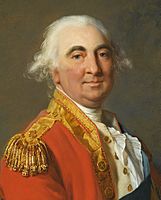Shelburne ministry facts for kids
Quick facts for kids Shelburne ministry |
|
|---|---|
 |
|
| 1782–1783 | |

Shelburne (1791)
|
|
| Date formed | 4 July 1782 |
| Date dissolved | 26 March 1783 |
| People and organisations | |
| Monarch | George III |
| Prime Minister | Lord Shelburne |
| Total no. of members | 16 appointments |
| Member parties |
|
| Status in legislature | Majority (coalition)
282 / 558 (51%)
|
| Opposition parties |
|
| Opposition leaders | |
| History | |
| Legislature term(s) | 15th GB Parliament |
| Predecessor | Second Rockingham ministry |
| Successor | Fox–North coalition |
This article is about the group of important government officials who worked together when Lord Shelburne was the Prime Minister of Great Britain. This period lasted from July 1782 to April 1783.
A "ministry" or "cabinet" is like a team of top leaders. These leaders help the Prime Minister run the country. They are in charge of different parts of the government.
Before Shelburne, Lord Rockingham was Prime Minister. He became Prime Minister in March 1782. But he sadly passed away just four months later. After Rockingham's death, Lord Shelburne was asked to form a new government. He had been the Home Secretary before this.
However, not everyone agreed with this choice. Charles James Fox and other members of the Rockingham Whigs party did not want to work with Shelburne. They decided to oppose his government. These people, known as the Foxites, joined forces with Lord North's supporters. Together, they worked to bring down Shelburne's government.
In April 1783, the Fox–North coalition took power. This was a new government formed by Fox and North. But this government also faced challenges. King George III did not like it very much. Because of this, many of Shelburne's former ministers returned to power later that year. They served under a new leader, William Pitt the Younger, in December 1783. Lord Shelburne himself was given the title Marquess of Lansdowne.
Shelburne's Cabinet Members
This section lists the main government leaders who served in Lord Shelburne's cabinet. These were the most important positions in the government at that time.
| Portfolio | Minister | Took office | Left office | Party | |
|---|---|---|---|---|---|
| First Lord of the Treasury (Prime Minister) | The Earl of Shelburne* | 4 July 1782 | 26 March 1783 | Whig | |
| Lord Chancellor (Chief Judge) | The Lord Thurlow | 3 June 1778 | 7 April 1783 | Independent | |
| Lord President of the Council (Adviser to the King) | The Lord Camden | 27 March 1782 | 2 April 1783 | Whig | |
| Lord Privy Seal (Keeper of the King's Seal) | The Duke of Grafton | 1782 | 1783 | Whig | |
| Chancellor of the Exchequer (Finance Minister) | William Pitt the Younger | 10 July 1782 | 31 March 1783 | Whig | |
| Secretary of State for the Home Department (Internal Affairs) | Thomas Townshend | 10 July 1782 | 2 April 1783 | Whig | |
| (Foreign Relations and Trade) | The Lord Grantham | 9 December 1780 | 2 April 1783 | Whig | |
| First Lord of the Admiralty (Navy Head) | The Viscount Keppel | 1782 | 1783 | Whig | |
| The Viscount Howe | 1783 | 1788 | Independent | ||
| Chancellor of the Duchy of Lancaster (Royal Land Manager) | The Lord Ashburton | 17 April 1782 | 29 August 1783 | Independent | |
| Master-General of the Ordnance (Military Supplies) | The Duke of Richmond | 1782 | 1783 | Whig | |
Changes in the Cabinet
- In January 1783, Lord Howe took over from Lord Keppel as the head of the Admiralty. The Admiralty was in charge of the navy.
Other Important Ministers
These individuals also held important government roles during Shelburne's time. However, they were not part of the main cabinet team.
- Henry Seymour Conway – Commander-in-Chief of the Forces (Head of the Army)
- Henry Dundas – Treasurer of the Navy (Managed Navy Money)
- Sir George Yonge – Secretary at War (Managed Army Affairs)
- Isaac Barré – Paymaster of the Forces (Paid the Military)
- The Duke of Rutland – Lord Steward of the Household (Managed Royal Household)

